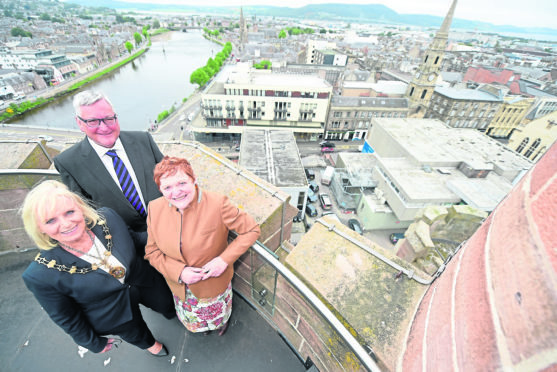Eyesore concrete blocks in the heart of Inverness are to be bought by the council as part of the castle redevelopment plans – paving the way to create a new tourism “gateway to the Highlands.”
Once the deal is concluded, Highland Council will own all three buildings in the city’s Upper Bridge Street – and the ground floor – as part of an estimated £5 million site purchase, part funded by £1.5 million from the Scottish Government’s City Region Deal.
Director of development and infrastructure Stuart Black, said the hope is to create an “international attraction” to rival the V&A museum in Dundee and serve as an economic “catalyst” for the regeneration of Inverness city centre.
Residents in Inverness – and across the Highlands – will be consulted on what they want to see happen at the site containing the 1950s and ‘60s office blocks, once described by Anglo-American travel writer Bill Bryson as “sensationally ugly”.
Council leader Margaret Davidson said plans for the newly-acquired site might incorporate a high-end hotel, roof gardens and new art gallery spaces to complement the castle plans which aim to showcase the history, culture and heritage of the Highlands.
Speaking yesterday, moments after the plans were unveiled, Ms Davidson assured that by the mid-2020s the castle and surrounding buildings would be a “completely different place.”
She added: “This is a once-in-a-century opportunity for Inverness. But this is also for the whole region. The castle will be a gateway to the Highlands and we will set it up so we are telling people about the culture and heritage across the length and breadth of the Highlands.
“Many people want a clean palette here. We should think about the British Museum, the National Museum in Scotland, the V&A museum in London – and soon in Dundee – as these have terrific numbers of visitors. Highland history and heritage is a fantastic starting point for us and so we need to talk about that.”
Author Bill Bryson famously described one of the Bridge Street buildings, along with another former office in the centre, as “two sensationally ugly modern office buildings that blot the town centre beyond any hope of redemption” in his book, Notes from a Small Island.
Inverness Castle project development manager Graham Watson said LDN Architects will now look at the Bridge Street site with a view to helping create a masterplan by the Autumn, prior to public consultation.
Mr Black said the options being put to the public for the top level buildings will be to either make “minor cosmetic improvements” to the existing buildings, refurbish certain parts of the structures or demolish what is there and start from scratch.
He said the purchase price for the site is still to be finalised and the borrowing will be secured by rent income from existing retailers on the lower level.
The council already owns Inverness Museum and Art Gallery and now takes over the former Crofting Commission building and a third block occupied by an Indian restaurant.
The local authority has never before now owned any of the ground floor – comprised of shops and restaurants – but the purchase covers all of the remaining buildings at Bridge Street which will give them total control.
Mr Black also said the council is in talks with the Scottish Futures Trust to help with long term funding for the chosen project.
Scottish Council for Development and Industry Highlands and Islands director, Fraser Grieve, said: “For too long has this important asset been detracted by its surrounding buildings and now we’re thankfully seeing a major step to enable the future redevelopment of this important site.
“This project will not only benefit Inverness but will support tourism throughout the region by opening up the castle and regenerating this gateway for so many visitors to the city.”
Rural Economy secretary Fergus Ewing, who has worked with the working group on the castle attraction plans since 2014, described it as an opportunity to “create something special of high architectural value – precisely the opposite of the existing buildings”.
